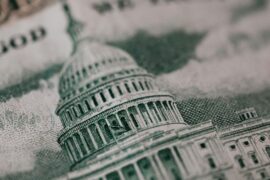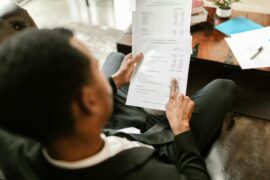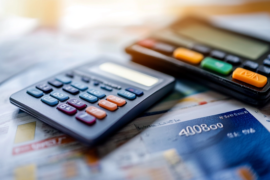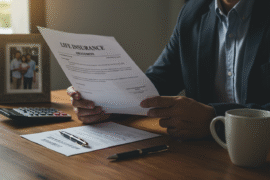This article may contain references to products or services from one or more of our advertisers or partners. We may receive compensation when you click on links to those products or services. Nonetheless, our opinions are our own.
Before you make the legal decision to declare bankruptcy, which can have significant and long-term effects on your income, property, loan eligibility, and business, it’s crucial that you understand the process.
In Canada, filing for bankruptcy means that you are unable to meet your financial obligations and must relinquish all of your assets. It also puts a stop on any legal action against you by creditors.
But taking this step is only a last resort, so exploring all other options first is important. Here are the steps you should take before filing for bankruptcy in Canada:
- Determine whether or not bankruptcy is the right option
- Weigh the pros and cons of filing
- Gather all of your financial documents
- Get in touch with a Licensed Insolvency Trustee (LIT).
- Transfer your bank account funds
- Cancel your automatic payments
- Get a copy of your credit report
- Get your paperwork in order.
- Begin budgeting more responsibly.
- Endnote
- Recommended Reads
Determine whether or not bankruptcy is the right option
Even if a company is in financial trouble, that doesn’t necessarily mean it should file for bankruptcy. Before declaring bankruptcy, research the different types of bankruptcies and evaluate your options to determine which is the best solution for you or your business. There are a few different reasons why someone would file for bankruptcy:
- To prevent creditors from taking your property
- To stop wage garnishments or other forms of debt collection
- To reorganize debts into a manageable plan
- To eliminate certain debts that are not dischargeable through repayment plans, such as tax debt and student loans
Bankruptcy is often best suited for those who have exhausted all other debt-relief options and cannot meet ends. For example, Air Canada faced a historic insolvency in 2003, and the company was granted bankruptcy protection by the Canadian court. The company was able to emerge successful by diluting 75% of it to its creditors.
Weigh the pros and cons of filing
Since bankruptcy can have serious long-term effects, it’s important to carefully weigh the pros and cons before deciding if it is the right decision for your situation. These are some of the potential benefits you may receive by filing for bankruptcy:
- All of your unsecured debt can be eliminated
- Creditors cannot take legal action against you
- You may receive relief from wage garnishment and collection calls
- Your credit score will be protected for up to 7 years
However, there are also a few drawbacks:
- Any assets that you own may be seized and sold in order to pay creditors
- Your credit score will take a significant hit and will remain affected for up to 10 years
- You may be required to surrender some of your income as part of the repayment plan
- It can also be difficult to get loans or secured credit for up to 7 years after filing for bankruptcy
However, bankruptcy is not intended as a punishment. You won’t lose all of your possessions even if you file for bankruptcy. Licensed Insolvency Trustees are bound by both federal and provincial laws that outline the assets exempt from seizure.
Gather all of your financial documents
Before you file, make sure that you have a full understanding of your financial situation. This means gathering documentation such as tax returns, bank statements, loan agreements, and credit card statements for the past two years.
You should also have proof of any income you have received, such as unemployment benefits. This information will help your Licensed Insolvency Trustee assess your situation and create a repayment plan that is tailored to you.
Get in touch with a Licensed Insolvency Trustee (LIT).
A Licensed Insolvency Trustee is a professional who specializes in debt management, bankruptcy, and insolvency. They are the only people legally allowed to file for bankruptcy on your behalf.
A LIT can provide invaluable assistance during this difficult time. They will review your finances, make sure you understand the process, and help you make an informed decision. They will also be able to answer any questions you may have about bankruptcy laws in Canada.
To find and connect with the most reliable bankruptcy trustee Ottawa, reach out to Doyle Salewski for personalized assistance and solutions.
Transfer your bank account funds
When you file for bankruptcy, you may face restrictions on your bank account. This means that you may not be able to withdraw more than a certain amount from your accounts, or transfer funds out of the country.
If you need funds from any accounts before you file, it’s best to transfer them out before the process starts. This is also a good time to open a separate account for your post-bankruptcy finances.
Especially if you have bills to pay, children or a family to care for, or other financial obligations, making sure you have enough money after filing is essential.
Cancel your automatic payments
If you have any bills that are set up on automatic payments, it’s important to cancel them before filing for bankruptcy. This includes things like rent or mortgage payments, credit card bills, and other monthly expenses. It also includes any insurance premiums, such as insurance for your car.
If you don’t cancel these automatic payments before the process starts, your creditors may continue to deduct funds from your bank accounts even after you file. This means that you could be charged more than you owe and still face penalties, so it’s best to cancel these payments in advance.
Get a copy of your credit report
Before you file, it’s important to know what is on your credit report. You can receive one free copy per year from each of the two major credit bureaus – Equifax and TransUnion.
Check your report for accuracy to ensure all of the information is correct. If you find any errors on your report, dispute them immediately so they don’t affect your bankruptcy filing.
If there is an issue, such as a debt that is not yours, or incorrect information about any past payment plans, you should deal with it before filing.
Get your paperwork in order.
Bankruptcy requires extreme accuracy—not just with the paperwork itself but also with any fees that are due. The court requires you to list all of your assets, debts, income, and expenses on an extensive packet of forms.
You will almost certainly need to hire an accountant (if you don’t have one already) and spend hours going through your financial documents in order to prepare your paperwork correctly.
Begin budgeting more responsibly.
Even though you are filing for bankruptcy, it’s important to start budgeting more responsibly and cutting back on unnecessary expenses now. This will help you get back on your feet faster after the bankruptcy is finalized, as well as give creditors confidence that you are serious about regaining control of your finances.
Start by making a list of all your income and expenses, including utilities, groceries, rent/mortgage payments, car payments, entertainment costs, etc., and develop ways to reduce spending or increase income where possible.
Endnote
Filing for bankruptcy is a difficult and stressful process that can have serious consequences. However, with the right preparation and guidance, you can make sure the process goes smoothly and take steps to rebuild your credit in the future. By taking these 9 steps, you will be well on your way to making sound financial decisions and starting fresh after bankruptcy.

Reviewed and edited by Albert Fang.
See a typo or want to suggest an edit/revision to the content? Use the contact us form to provide feedback.
At FangWallet, we value editorial integrity and open collaboration in curating quality content for readers to enjoy. Much appreciated for the assist.
Did you like our article and find it insightful? We encourage sharing the article link with family and friends to benefit as well - better yet, sharing on social media. Thank you for the support! 🍉
Article Title: 9 Steps to Take Before You File for Bankruptcy
https://fangwallet.com/2023/01/09/9-steps-to-take-before-you-file-for-bankruptcy/The FangWallet Promise
FangWallet is an editorially independent resource - founded on breaking down challenging financial concepts for anyone to understand since 2014. While we adhere to editorial integrity, note that this post may contain references to products from our partners.
The FangWallet promise is always to have your best interest in mind and be transparent and honest about the financial picture.
Become an Insider

Subscribe to get a free daily budget planner printable to help get your money on track!
Make passive money the right way. No spam.
Editorial Disclaimer: The editorial content on this page is not provided by any of the companies mentioned. The opinions expressed here are the author's alone.
The content of this website is for informational purposes only and does not represent investment advice, or an offer or solicitation to buy or sell any security, investment, or product. Investors are encouraged to do their own due diligence, and, if necessary, consult professional advising before making any investment decisions. Investing involves a high degree of risk, and financial losses may occur including the potential loss of principal.
Source Citation References:
+ Inspo












































